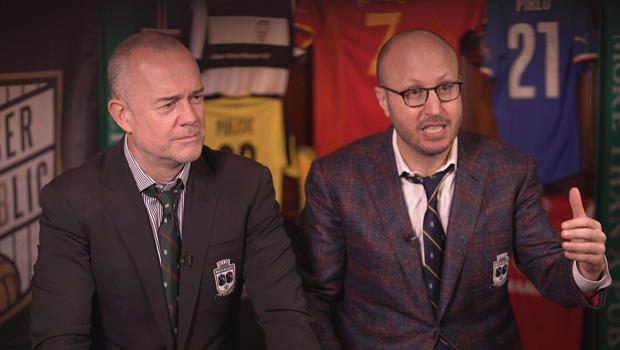It’s Croatia against France in today’s final round of the World Cup in Russia. “The Beautiful Game,” is what soccer fans call it. And as Jim Axelrod now tells us, you don’t have to travel far to find them:
If you didn’t know any better, watching crazed fans packing bars to yell at TV screens showing soccer games, you might think you were in Barcelona, or Buenos Aires, or Berlin.
But guess again, and this time try New York, Washington, D.C., and San Francisco. And it’s been this way for the last month, with American fans glued to games played halfway around the world.

U.S. fans enjoy watching a game of football that actually involves kicking a ball with feet.
CBS News
The World Cup, held every four years, is the most widely-viewed sporting event on the planet. A billion people are expected to watch today’s final in Russia. That’s ten times the U.S. audience for the Super Bowl.
And while it’s taken a while for soccer to reach “big league” status here, it would appear America’s finally joined the party.
These days, only baseball and basketball outrank soccer as sports American kids play; and attendance at the top U.S. pro soccer league is up nearly 60 percent in the past 20 years.
No one’s cheering louder about this than Roger Bennett (“The honest truth is, soccer is here. It’s here”) and his fellow transplanted Brit, Michael Davies. Known as the “Men in Blazers,” the two feature much more than their finely-tailored sports coats; they have a wildly popular, celebrity-laden podcast, a new book, and a traveling stage show, irreverently extolling the appeal of the game that is exploding here.
“There is nothing that is more shocking to us than people listen to our crap,” said Davies.
Soccer has a long history as the Next Big Thing in this country’s spectator sports landscape, what Bennett termed “constant false prophecies that it was gonna be the Next Big Thing, the next Rubik’s Cube, the next pogo stick, the next yoyo. It’s been a fad.”
But starting with the 1994 men’s World Cup, when nine different U.S. cities hosted games, the “fad” has grown into something more durable.
In 1999 the U.S. hosted the women’s World Cup, and won it all in the most dramatic fashion.
“When I see it sometimes I get nervous, like thinking, ‘What if it doesn’t go in this time?'” said Brandi Chastain.
Who can forget her gender-empowering moment:
[embedded content]
“I just hit it as hard as you can, and then the rest was just what you dream about on playgrounds,” Chastain said.
Nearly two decades after that moment, the number of girls playing high school soccer has soared fifty percent.
Chastain said, “There’s millions of young girls who are playing soccer now, and they deserve a place to dream and a place to believe that those dreams could come true.”
Forget the Men in Blazers saying soccer’s future here is secure; try the woman in the sports bra. “Without a doubt, the game is here to stay,” Chastain said. “The numbers absolutely prove that.”
But like just about every other part of our culture, understanding soccer’s growth in America is a matter of understanding the technology.
“Baseball’s Golden Age coincided with the Golden Age of radio,” said Bennett. “The NFL, once the television came, was unstoppable. The Internet Age, soccer is the perfect internet sport.”

The Men in Blazers: Michael Davies and Roger Bennett.
CBS News
Highlights of stunning goals now rocket around the world, in the way they couldn’t have a generation ago.
“The emergence of social media – Twitter, Instagram – where soccer is a dominant sport because it’s a global thing,” Davies said.
And with the explosion of soccer video games – now a competitive sport themselves – Americans are connected to teams and fans from every corner of the globe. “We call it the silent hand that has grown the game we love in the country we love,” Bennett said. “It’s been an incredibly powerful driver.”
The kicker? All this excitement, and American fans didn’t even have a national team to root for in this year’s World Cup. The U.S. squad failed to qualify for this year’s tournament.
Axelrod asked, “Does the U.S. men’s team not making the World Cup stall the momentum?”
“No,” Davies replied. “I think the momentum is already there.”
And there’s one more thing: In 2026 the World Cup will coming to America. The U.S. was just named co-host, with Canada and Mexico, and with that comes automatic entry to the tournament.
So, if you think this past month’s World Cup fever reached a new height in this country … just wait.
For more info:
Story produced by Jon Carras and John Goodwin.

